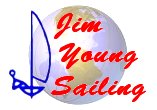

 |
|
|
|
|
|
Hey!! Check out our Sale Bin for goodies at great prices!!
Things to tie knots in....
A selection of some of the latest solutions. Not everything, just the best for each job as listed below on your boat. And not all colors are here, because we really believe in color-coding boats, to make life easier on crews, and coaches. Of the major line choices - Mafioli, Marlow, New England, Samson, and Yale - we tend to prefer New England. They have the most experience making braided lines that don't distort around blocks, which makes lines run easier. Other than that, there is no real reason to choose one company over the other except to reduce the headache when you open a web site with a the huge variety of lines with little guidance to application.
Why do you need or want the newest, best, etc., for the lines on your boat? Simple answer, because the newest lines DO work instead of MAKING work. The issues are low or no stretch, high strength so lines can be smaller (less windage, really important for halyards), or the opposite, lines so light that they can be upsized to make them easier on the hands, lines that absorb little or no water and float, important for lines that can easily droop or drop into the water, plus the issues of ease of handling, ability to hold in cleats or on winches, and even stay kink-free under most conditions, important in dinghy cockpits and critical in tube-lauched asymetric spinnaker halyard/pull down systems.
As with everything that we sell, the prices are typical of what you can find elsewhere. Yes, we can splice most of this stuff if you want loops or eyes, but it will take longer and cost more. The only lines we normally splice are the single braids like Endura 12, some of the newer double braids are difficult to work with. The only spliced lines that we normally stock are 420 mainsheet bridles.
If you have questions, need advice, or splices that are not listed below, or if you are ordering for shipment outside the USA, contact us , and we will give you our best advice, and a quote if is something we can do, and delivery time.
Lines are listed by applications (if the link or "Add
to Cart" button is not active, it means the line is not currently in
stock) ~
![]() sheets
sheets
![]() halyards
halyards
![]() bridles
bridles
![]() vangs
vangs
![]() control
lines
control
lines
![]() utility
lines (and Opti sail ties)
utility
lines (and Opti sail ties)
![]() painters
painters
![]() shock
cord
shock
cord
![]() Complete
Chart of all lines stocked, with descriptions of fibers used in line
construction
Complete
Chart of all lines stocked, with descriptions of fibers used in line
construction
Looking for catamaran trapoline lacing? See utility lines.
Please note, for line diameter, we are switching over to all metric sizes, we got tired of converting all the time! For line length and pricing, we will stay with feet and inches, at least for a while. Here is a conversion chart to help you out:
3mm 1/8 • 4mm 5/32 • 5mm 3/16 • 6mm 1/4 • 7mm 9/32 • 8mm 5/16 • 9.5mm 3/8 •12mm 1/2
1" = 2.54 cm
1' = 30.48 cm
1 yard = 91.44 cm
1 meter - 39' 4 5/16"
NOTE: When ordering line by the foot, use the Quantity box on the order confirmation page to show the number of feet you are ordering.
 For
a while, to have the best sheets, you had to have Mafioli, the very first
of the new breed of blended sheet lines - they first used Polypropylene
and Nylon and have moved on to Dyneema and Nylon as well as some other tricks.
Jim first started using it for Tornado sheets in Europe in the late '90's.
But for all its wonderful feel, Mafioli has problems. It is expensive (made
in Italy, where the US$ does not go very far), it distorts under load (they
now have a version that is more dimensionally stable - and lacks the great
soft feel of the original, and is much more expensive), and it wears quickly.
There are also copies of Mafioli sold in the US, under names such as Racing
Sheet. New England Ropes caught up quickly with their Bzzz line, a great
blend of polypropylene and polyester. It is soft but doesn't crush in cleats
or around blocks, doesn't hold much water, floats, wears very well, is not
very expensive, and stays relatively kink-free, a big plus in any cockpit
or trampoline. They make 2 sizes, 7 and 8 mm. We currently stock 8mm in
one color and 7mm in two. (New England only makes each size in two colors,
and the 8mm gray has not sold well so we have discontinued it here. We do
have some spool ends of that line in our Sale Bin.).
For
a while, to have the best sheets, you had to have Mafioli, the very first
of the new breed of blended sheet lines - they first used Polypropylene
and Nylon and have moved on to Dyneema and Nylon as well as some other tricks.
Jim first started using it for Tornado sheets in Europe in the late '90's.
But for all its wonderful feel, Mafioli has problems. It is expensive (made
in Italy, where the US$ does not go very far), it distorts under load (they
now have a version that is more dimensionally stable - and lacks the great
soft feel of the original, and is much more expensive), and it wears quickly.
There are also copies of Mafioli sold in the US, under names such as Racing
Sheet. New England Ropes caught up quickly with their Bzzz line, a great
blend of polypropylene and polyester. It is soft but doesn't crush in cleats
or around blocks, doesn't hold much water, floats, wears very well, is not
very expensive, and stays relatively kink-free, a big plus in any cockpit
or trampoline. They make 2 sizes, 7 and 8 mm. We currently stock 8mm in
one color and 7mm in two. (New England only makes each size in two colors,
and the 8mm gray has not sold well so we have discontinued it here. We do
have some spool ends of that line in our Sale Bin.).
For boats needing a larger diameter line, New England's Salsa
- a  blend
of polyester, polypro and Dyneema - much stronger, and more expensive -
is the next step up. All the dinghies we have put Bzzz on love it, including
Lasers. It works so well that Jim began recommending it for the hard-core
catamaran distance racers - and it became the standard sheet line on NACRA
20' catamarans produced in the US. European-produced Nacras now use
the Portugese-made Alpha lines as standard. We have a few spools
of Alpha's SSR Lite on hand, in 6mm ($1.19/ft) and 8mm ($1.59/ft),
it's a high-tech, high load, high-priced sheet line - mains and jibs - that
is stiffer than Bzzz but awesome in-out of cleats because of its harder
finish. That makes it a superior catamaran sheet. If this is what you need,
contact us for current colors. SSR Lite cannot
be tapered or spliced.
blend
of polyester, polypro and Dyneema - much stronger, and more expensive -
is the next step up. All the dinghies we have put Bzzz on love it, including
Lasers. It works so well that Jim began recommending it for the hard-core
catamaran distance racers - and it became the standard sheet line on NACRA
20' catamarans produced in the US. European-produced Nacras now use
the Portugese-made Alpha lines as standard. We have a few spools
of Alpha's SSR Lite on hand, in 6mm ($1.19/ft) and 8mm ($1.59/ft),
it's a high-tech, high load, high-priced sheet line - mains and jibs - that
is stiffer than Bzzz but awesome in-out of cleats because of its harder
finish. That makes it a superior catamaran sheet. If this is what you need,
contact us for current colors. SSR Lite cannot
be tapered or spliced.
We also have another great choice, see 6mm Euro-style Endura under Spinnaker Sheets, it is taperable, could be used as a tapered main or jib sheet on dinghies where a 6mm line is appropriate.
About "non-kinking' lines: There is a lot of hype around so-called non-kinking lines, that sells line that is more expensive but not any better in the boat. These two lines, Bzzz and Salsa, are single-braids that are very soft and resist kinking very well. Kinks come in double-braided lines (lines with separate cores and covers) where the core is stronger than the cover and twists inside of it under load. One way to combat that is to have a cover that is stronger than the core, as is done in one very-hyped and expensive line. This results in a harder, stiffer line that is harder on the hands and doesn't play out as well in really light winds. The other, less expensive and easier on the hands solution, is the one New England has worked hard on, these two lines. They do just as good a job, without the hype or price of the over-sold lines. If these had any kinking tendencies at all, they would never be used on 8- or 10- to one catamaran mainsheet systems - and they are the sheets of choice for that use.
If you want or need a tapered main sheet, we now have 8mm NER Euro-style Endura Braid (in Green only unless we get requests for other colors). You can find both 6mm and 8mm Endura Braid farther down the page under Spinnaker Sheets.
|
7mm Bzzz, Blue, .81/ft |
Some recommendations: (Prices are a bit better than per foot on most of these because we make them in batches ahead of time for many dinghies, not per order.)
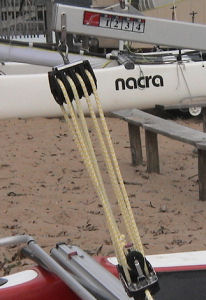
| ~ Opti mainsheet, 21 ft 7mm, $13.49
or if grip is an issue (smaller hands), then 8mm, $16.39 ~ 420 mainsheet, 25 ft 8mm, $18.75 ~ 420 jib sheet, 25 ft 7mm, $15.75 (See the tail trick below under Spinnaker Sheets, and add $10) ~ Butterfly main, 38 ft 8mm, $29.25, I prefer slightly smaller, 7mm, $23.95 ~ Laser main, 46 ft 7mm, $28.98 ~ Sunfish main, 28 ft, 8mm seems preferred, $21.49, but I'll make you a 7mm one for $17.64 NOTE: as of early June 2021, we are OUT of 7mm Bzzz Green. The mill says they will be able to ship more by mid-July. |
~ Catamaran mainsheets, use 8mm Bzzz for boats up through 18ft, and for
larger boats, 20ft+, use 10mm Salsa. These are smaller diameters than
most cat sailors think of as normal, but they really grip easily, in both
the hands and the cleat, and its truly wonderful have a mainsheet line
that plays out so easily when its time to sheet out. Most catamaran sailors,
in the search for better grip, put on sheet lines that are too large.
This creates two problems; one, the line does not run out as freely, and
two, the larger diameter has a greater 'turning resistance' that actually
makes it harder to pull in under load. You need to custom-order your own
length, which varies not only from boat to boat, but with individual mast
rake as well. Cat jib systems are sometimes cascaded, used Endura 12 or
one of the Spyder lines for the multi-purchase part, and something 6mm
or 7mm for the end that goes through cleats and hands. And if you want
a tapered mainsheet for your cat, we recommend 8mm Endura (see below!)
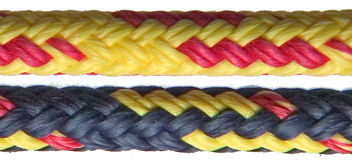 For
dinghy, small to medium keelboats and catamaran spinnakers, we recommend
New England's Flight Line, a multifilament polypropylene (MFP) cover over
a braided Dyneema core. It can be tapered to reduce weight on the ends,
is lighter than most other options, is easy on the hands, expecially after
a bit of use, and it does not absorb water, great perfect for dangling
lines in light air. We recommend it for spinnakers, but it can also be
used for tapered main or jib sheets. As an alternative for crews who don't
sail as much and have softer hands, or boats with tighter budgets, Bzzz
Line (see Main and Jibs Sheets above) can be used, but note that it cannot
be tapered. Most catamaran sailors have moved towards Bzzz for spinnaker
sheets, they like the superior grip and easy feel of it compared to Flight
Line, especially when the wind gets nasty. The trade off is that Bzzz
is just a bit heavier and does pick up a bit of water.
For
dinghy, small to medium keelboats and catamaran spinnakers, we recommend
New England's Flight Line, a multifilament polypropylene (MFP) cover over
a braided Dyneema core. It can be tapered to reduce weight on the ends,
is lighter than most other options, is easy on the hands, expecially after
a bit of use, and it does not absorb water, great perfect for dangling
lines in light air. We recommend it for spinnakers, but it can also be
used for tapered main or jib sheets. As an alternative for crews who don't
sail as much and have softer hands, or boats with tighter budgets, Bzzz
Line (see Main and Jibs Sheets above) can be used, but note that it cannot
be tapered. Most catamaran sailors have moved towards Bzzz for spinnaker
sheets, they like the superior grip and easy feel of it compared to Flight
Line, especially when the wind gets nasty. The trade off is that Bzzz
is just a bit heavier and does pick up a bit of water.
 Another
alternative that we see being used more is NER's Euro-style Endura. With
its polyester cover and Dyneema core, its very strong, low stretch, low
water absorbtion, winch and hand friendly, and can be tapered. We are
carry two sizes, 6mm, suitable for smaller spinnakers, dinghy mains, and
most jibs, and 8mm, for larger spinnakers and higher-load mainsheets,
especially catamarans..
Another
alternative that we see being used more is NER's Euro-style Endura. With
its polyester cover and Dyneema core, its very strong, low stretch, low
water absorbtion, winch and hand friendly, and can be tapered. We are
carry two sizes, 6mm, suitable for smaller spinnakers, dinghy mains, and
most jibs, and 8mm, for larger spinnakers and higher-load mainsheets,
especially catamarans..
Tapered ends are $15 for EACH taper, you will need to send us
a separate note to tell us the details of the
tapers, such as how much from each end. If you are not sure of the taper
details, use the link above to send us a note and we can correspond with
you to get it right - and then send you a separate electronic invoice
for payment so you do not have to come back here to order.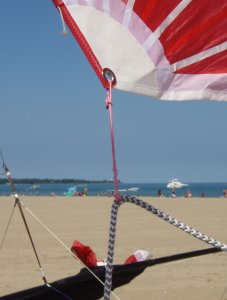
|
6mm Euro-style Endura mottled blue, $1.89/ft |
~ catamaran spinnakers, 8mm, measure your line and send us a note for a quote. Tell us if you want the spinnaker clew tail as shown above right (no knot to get hung up during a jibe and no bulky knots have to slide in and out of the tube), the ends then get taped together on the trampoline so there is no knot to hang up there either. It adds $10 to the cost - I use Endura 12 for the tail. Nacra supplies 8mm Bzzz as standard spinnaker sheets.
![]() For
mainsails, there are two ways to do this: The first is a cleat or hook
on top of the mast, in which case the halyard just pulls the sail up to
the hook at or near the block that the line runs over on the mast head,
so your choice is based on ease of handling. Low stretch is a plus, so
the sail actually goes up the mast instead of just stretching the halyard,
something that can really tire you out trying to get a newer sail up the
mast. My choice for this on dinghies is New England Rope's Sta Set. Nice
handling, its a prestretched line that is not over-done and too stiff. A choice for catamarans is Spyder Line, it is more
expensive, just as easy to handle, and has virutally no stretch under
a short-term load, like hoisting a sail. Because it has a Dyneema core,
it can be downsized - which helps a lot on boats that have the main halyard
running up the luff track.
For
mainsails, there are two ways to do this: The first is a cleat or hook
on top of the mast, in which case the halyard just pulls the sail up to
the hook at or near the block that the line runs over on the mast head,
so your choice is based on ease of handling. Low stretch is a plus, so
the sail actually goes up the mast instead of just stretching the halyard,
something that can really tire you out trying to get a newer sail up the
mast. My choice for this on dinghies is New England Rope's Sta Set. Nice
handling, its a prestretched line that is not over-done and too stiff. A choice for catamarans is Spyder Line, it is more
expensive, just as easy to handle, and has virutally no stretch under
a short-term load, like hoisting a sail. Because it has a Dyneema core,
it can be downsized - which helps a lot on boats that have the main halyard
running up the luff track.
![]() The
other way to cleat a main is a halyard that not only pulls the sail up
but then runs back down the mast and is cleated somewhere around the mast
base, in which case you want absolute minimum stretch. My choice here
is one of two wonderful blends from New England, their Endura Braid in
larger sizes, or Spyder Line for smaller boats. (A New England Ropes naming
curiosity, be careful to distinguish between Endura 12, the high tech
core of Endura Braid that is sold separately, and the Endura Braid double-braided
line.) The core is Dyneema/Spectra, with a polyester cover on both of
these lines, so they are really strong with virtually no stretch at small-boat
loads, in a package that will tie and cleat easily thanks to the cover.
The
other way to cleat a main is a halyard that not only pulls the sail up
but then runs back down the mast and is cleated somewhere around the mast
base, in which case you want absolute minimum stretch. My choice here
is one of two wonderful blends from New England, their Endura Braid in
larger sizes, or Spyder Line for smaller boats. (A New England Ropes naming
curiosity, be careful to distinguish between Endura 12, the high tech
core of Endura Braid that is sold separately, and the Endura Braid double-braided
line.) The core is Dyneema/Spectra, with a polyester cover on both of
these lines, so they are really strong with virtually no stretch at small-boat
loads, in a package that will tie and cleat easily thanks to the cover.
Jibs and spinnakers are normally cleated somewhere down low, so the best solution is using one of the two lines mentioned above, Endura Braid or Spyder Line, and tapering it (stripping the cover off of part of the length), so that when the sail is up only a small-diameter line is running down the mast, but from where it enters the cleat, it has a cover on it to help hold better in the cleat and be easier on the hands.
The hot solution for spinnaker halyards is 5mm Endura Braid, tapered. Hoist your spinnaker, and mark your halyard line about 1-foot in front of (on the spinnaker side!) of the cleat, then take it all down and measure from that mark to the end of the halyard (the end that ties to the spinnaker), that is how much can be stripped off for a tapered halyard. If you are in doubt, Send us a note to be sure we get it right for your boat.
Tapers; We can taper both Spyder Line and Endura Braid by stripping off the cover for the specified length. Tapers are priced EACH, use the drop-down box, "Add to Cart" button and Quantity box to tell us how much to taper from the end.
A special note on tube-launched spinnakers and their one-piece halyard/take down line; we constantly get requests for 'easy-handling' (for hoisting) or sometimes 'slippery' lines (concern about pin holes in the spinnaker from line abraision during take-down). The JOB of a spin halyard is to hold the spinnaker up - and not stretch! That is what that line spends most of its useful life doing. It is in the hands for literally seconds during a race, so low stretch far outranks easy on the hands. And 'slippery' is something that doesn't combine well with either hands or cleats. Lines that are made specifically as sheet lines - like Bzzz, or the various lines that look and behave like the soft and fuzzy Mafioli Swiftcord - are not good choices for halyards for anyone except the non-racing, light-air-only recreational sailor.
And for simple halyards on small boats, that cleat on top of the mast, Sta Set is a good-handling, easy choice, that behaves well in mast-head cleats and hooks.
|
3.8mm Spyder Line Purple, $.73/ft |
|
~ Butterfly 5mm (3/16"), $17.50 |
~ Catamaran main halyards, 5mm Sta Set or 3.8 mm Spyder Line.
~ Jib halyards, tapered 5mm Endura Braid if it is cleated on the mast
AND there is wire in the jib luff that becomes the forestay while sailing.
~ Catamaran jib halyards 1.8mm Spyder line if the line runs up and back
down the jib luff inside of a zipper.
OR 2mm braided poly if the line runs up
and down inside the jib luff but there is a hook up high.
~ Catamaran spinnaker halyards, tapered 5mm Endura Braid, custom cut,
depends upon spinnaker snuffing system.
![]() One
choice is Endura 12, a super strong 12-plait made of Dyneema and Spectra,
coated to make it easier to handle, no stretch at these loads (see chart),
no water absorption, very UV resistant - and like all the modern 12s,
easy to splice, especially the slip splices that make something like a
420 or 49er bridle easy to adjust. NOTE; this line can replace
wire in many applications - including trapezes - except standing rigging.
One
choice is Endura 12, a super strong 12-plait made of Dyneema and Spectra,
coated to make it easier to handle, no stretch at these loads (see chart),
no water absorption, very UV resistant - and like all the modern 12s,
easy to splice, especially the slip splices that make something like a
420 or 49er bridle easy to adjust. NOTE; this line can replace
wire in many applications - including trapezes - except standing rigging.
The other choice, Validator 12 from Samson, the description is very much
the same as above except it is made of Vectran, which means zero stretch
and higher price. This is the line to use where the load is very high
for long periods of time (hours instead of minutes), because this line
has no 'creep'. Two other points to be aware of, it is not quite as UV
resistant as a Dyneema/Spectra line, and if you are pushing the load limits,
(usually not an issue on most small - under 25 ft - boats) it does not
quite have the same tensile strength. 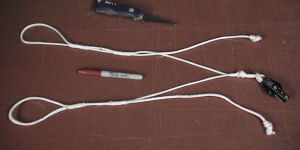
| Endura 12, 1.8mm, grey, $.27/ft Endura 12, 3mm, Red, $.55/ft Validator 12, 3mm, Red, $.67/ft |
| ~ 420 bridle, 9 ft, just the line, 3mm Endura 12, you get to rig it
yourself, $4.50 ~ 420 bridle with splices and center eye loop as pictured right - but without block, $17.00 |
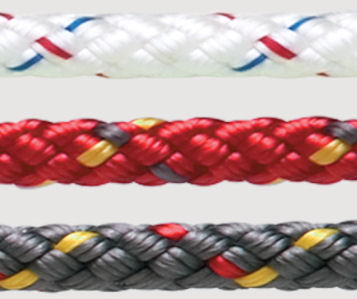 Now
you get to choose. I recommend Endura 12 for cascading vangs, the cascade
part. The other end that goes to a cleat should be Finish Line for ease
of handling and cleating. Most small single-handed boats can use Sta Set for the entire vang, for bigger, 2 and 3 person boats, go to Spyder
Line for the entire vang to handle the extra load.
Now
you get to choose. I recommend Endura 12 for cascading vangs, the cascade
part. The other end that goes to a cleat should be Finish Line for ease
of handling and cleating. Most small single-handed boats can use Sta Set for the entire vang, for bigger, 2 and 3 person boats, go to Spyder
Line for the entire vang to handle the extra load.
Spyder Line colors are shown below, under Control Lines. Note that Sta Set is a prestretched line,
so that it has very little stretch under normal loads, and is very reliable in cleats of all types.
|
2.8mm Spyder Line Mango $.53/ft |
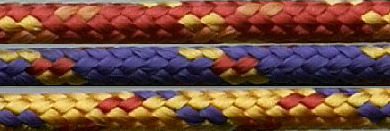 Most
control lines are short, go through your hands to a cleat. Use Finish
Line (examples are simple outhauls and cunninghams). If its a long, multipurchase
control, use Endura 12 if it ends in a block that is tied to the tail
of the part being handled and cleated, or Spyder Line if it is all a single
line. Examples of the first are cascading vangs, and mast rake control
systems, examples of the second are 3-, 4-, or more, -to-one vang systems.
The continuous double-ended cunningham systems on modern catamarans should
have just a bit of 'give', it will save the halyard hook at the mast top
from blowing out. Use Sta Set.
Most
control lines are short, go through your hands to a cleat. Use Finish
Line (examples are simple outhauls and cunninghams). If its a long, multipurchase
control, use Endura 12 if it ends in a block that is tied to the tail
of the part being handled and cleated, or Spyder Line if it is all a single
line. Examples of the first are cascading vangs, and mast rake control
systems, examples of the second are 3-, 4-, or more, -to-one vang systems.
The continuous double-ended cunningham systems on modern catamarans should
have just a bit of 'give', it will save the halyard hook at the mast top
from blowing out. Use Sta Set.
| 2.8mm Spyder Line Mango $.53/ft
3mm Endura 12 Red $.55/ft 3.8mm Spyder Line Purple $.77/ft 5mm Sta Set Red $.49/ft 5mm Sta Set Blue $.49/ft |
Utility lines are lines that do everything else - cover ties, standup lashings on a block base, attaching blocks instead of using shackles, rudder safety lines, whatever else your imagination can come up with. The 1.8mm Spyder Line or 2mm Mimi-V are great solutions for Opti sail ties. 5mm Stay Set is a do-everything, 3/16" line, like board controls, topping lifts, spinnaker twings, simple cunninghams/downhauls and outhauls, anywhere a line job needs to get done and handling/cleat-holding are more important than strength or zero-stretch.
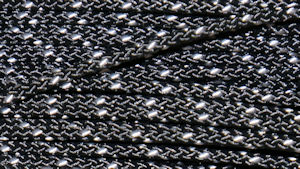 We
include our newest offering, NER 2mm Mini-V, under Utility lines, simply
because it doesn't fit easily anywhere else! It is the high-tech choice
for Opti sail ties and for catamaran trapoline side lacing on catamarans
(that use side lacing, not center laces. Use 2.8mm Spyder Line on all
rear tramp lacing. Older cats with center laces can use 5mm Stay Set for
center and rear lacing. Another high-tech choice for tramp lacing is the
Validator 3mm, you'll find it above listed with Bridle lines.
We
include our newest offering, NER 2mm Mini-V, under Utility lines, simply
because it doesn't fit easily anywhere else! It is the high-tech choice
for Opti sail ties and for catamaran trapoline side lacing on catamarans
(that use side lacing, not center laces. Use 2.8mm Spyder Line on all
rear tramp lacing. Older cats with center laces can use 5mm Stay Set for
center and rear lacing. Another high-tech choice for tramp lacing is the
Validator 3mm, you'll find it above listed with Bridle lines.
|
~1.8mm Spyder Line Red or Black $.27/ft |
Painters deserve a bit more respect than what they usually get, which is assigning any old, worn, leftover chunk of line to painter duty. If you sail all of your life on a little puddle, and never tie your boat to a dock anyway, maybe that's OK. But if you live on a big puddle (especially if it tastes salty), and regularly go to other puddles for racing, you need to worry about your painter, 'cause its not nice to tie your boat up among a large group of boats and have a line that just might not be up to the job, endangering your boat and all those around you. If you ever need a tow, because of too little, or too much wind, especially after a rescue in big waves, your tow line is your life line.
(Just before Hurricane Katrina hit, I was in Panama City FL, and helped tie up boats that did not have owners in the area. One keel boat, at a club dock, was tied with old jib sheets, that had already broken doing what they were bought to do. Care to guess how secure that boat was? Or how safe the docks and any other boats were?)
And if you want to help your rescue/tow boat do its job, your painter needs to be long, and it needs to float. For length, something around 1.5 to 2 times the length of your boat is needed to tow behind a powerboat, and to float, it needs to be made of polypropylene.
Finally, check your class rules, it may specify the length and diameter of the line. As an example, here is what the C420 class rules say about a painter:
"7.2 One mandatory rope painter, not less than 8 meters long and of 8mm diameter securely attached to the boat, and which can be grasped at the stem at all times."
If you don't have a conversion table handy, 8 meters is 26' 3", not 24' as one print catalog claims.
You can get by with water ski tow rope, but don't be surprised when the knots don't stay tied.
I offer one solution: Marlow's Marstron 8-plait polypropylene line. Its so good that its used as an inexpensive mainsheet on many small boats. (For keelboats, I suggest Samson's MFP Floatline, a polypropylene core with a nylon cover, much stronger than just polypro - and also more expensive. I don't stock it, but you can find it at West Marine, use this link and enter 2671642 in the product search box.)
This is the most important place on the boat for a yellow line, so it can be easily seen in difficult weather or floating on the water.
|
Marlow Marstron, 8mm, Yellow, $.55/ft ~ C420 class legal-painter painter, $11.29 |
Things that go snap in the night. Most common use is for hiking strap holdup, next is as a tail, such as on a trapeze wire, so there is always tension on the wire and it doesn't go flopping about on its own, or on the pull-down side of a topping lift line. Also used as sail ties, to furl a jib or roll a sail around the boom. Best use is as tie lines around all the wires on a mast during travel. Use your imagination.
We have added 3mm for 2014 for those many smaller jobs. The more common 5mm is typically used as a trapeze retractor on everything from C420 up to Tornado. If you need something else, click here to go to West Marine and enter "shock cord" in the search box to find other options.
| 3mm shock cord, white with red
flecks, $.14 5mm shock cord, blue, $.29/ft |
3mm 1/8 • 4mm 5/32 • 5mm 3/16 • 6mm 1/4 • 7mm 9/32 • 8mm 5/16 • 9.5mm 3/8 •12mm 1/2
So you want to buy something that you don't see here or you are not sure what you should buy? We are here to help, contact us so we can get it right the first time. We will bill you by email for payment through Pay Pal with credit card or electronic check
If you would like more information on these products, send us an info request.
![]()

© 2007-15 Jim Young